|
Where Have All the Puzzles Gone? (Part I)
I was fortunate to get into computer gaming in a watershed period around 1985, when text-based
(interactive fiction) games were nearing the end of their reign, and adventure games with graphics, like
Leisure Suit
Larry in the Land of the Lounge Lizards were just beginning to emerge. I was fortunate because, for
a time, I had the best of both worlds.
Though the puzzles in well produced text-based offerings like Dungeon (the prototype for Zork, made
while the guys from Infocom were still at MIT), and Hitchhiker's Guide to the Galaxy were devilishly
difficult, the early graphical adventures were quite tough to get through in their own right. For one
thing, although the games were point-and-click as far as moving your character around on the screen went,
you still had to type in commands to accomplish any in-game action. You might have already figured out
how to solve a particular puzzle, but depending on how well the parser for the game in question was
designed, good luck figuring out what words to type in to make your character execute the solution. Also,
the Web as we know it today was only an inkling in the eventual founding fathers' collective imaginations.
So if you got stuck, the only recourse was to get a like-minded friend to pitch in with some fresh ideas.
But nonetheless, the adventure gamers of that period somehow managed to muddle through, and if I recall
correctly, we had a great time of it in the process.
Between 1987 and 1992, I don't remember playing anything very remarkable, except Prince of Persia (different
genre, so we won't be going there), Quest for Glory: So You Want to be a Hero?,
and... King's Quest V. This one was another toughie, but in retrospect I
realise this was due to some questionable puzzle design/long dead ends (see below for definitions if you're not
familiar with that term).
So now we come round to the gist of this series of articles: I'll be examining the puzzle design in graphical
adventure games made from circa 1993 onwards. This roughly marks the beginning of the era when we said bye-bye to
text parsers, and I feel that I can compare these games to modern games without trying to compare apples to oranges.
We'll be having a look at what I consider to be good examples, bad examples, and downright ugly examples of puzzles
from the past 15 years of adventure gaming. Hey, no one can claim to be an 'expert' in these matters. So please bear
in mind that these are only my opinions of the games being considered. Everyone has their own favourites, and if I
happen to trash a game that you absolutely love, then I apologise in advance. Please send me an e-mail, and we can
discuss further. Likewise, if you agree with what I'm saying, shoot me an e-mail as well. In either case, I'll ask
for your permission before posting anything discussed in an e-mail on my blog.
As with most articles of this nature, you can be certain that something that happened quite recently prompted
the author to write it. And that something in this case was the observation that for the most part, in the latest
crop of adventure titles... the puzzles suck. Being a programmer myself, the logical quality of the puzzles really matters
to me, and I think it matters to most veteran adventure game players as well. Over time, you develop expectations of
what the puzzles should be like, and what the clues provided to aid you in solving them should be like. It's also no
coincidence that I've written detailed walkthroughs for most of the better games that I'll be using as examples in these
articles. That's because I thought they were so much fun to play that they deserved to be documented - because people
will be playing these classics for years to come.
Some ground rules
My definition of an adventure boils down to this: story telling puzzle game. An adventure might be a bit light in
the story telling department, but make up for it with excellent puzzles (Myst,
for example). Or, a game might have an exceptionally strong story line, but fall short on the puzzle side of
things. That would be Dreamfall: The Longest Journey. Granted, that leaves
us with a pretty broad spectrum of possibilities to consider, but we'll be including representative samples between
these two extremes in this discussion.
One thing I'm not overly fond of concerning the way generalist/mainstream sites typically review adventure games is
the way they often nitpick about certain adventure game puzzles in the review text, and wind up spoiling the game by
giving away the puzzle solution right there in the review. Well, we're going to try not to do that here. Mindful of
the fact that not all of you reading this may have played all the games being discussed, the spoilers will be hidden
so that you have to click and hold the mouse over them in order to to view. It's impossible to write an article of
this nature without including spoilers, so it's the least I can do.
We're also going to need to define some terminology before we can discuss certain puzzle design 'sins' in a
meaningful way:
Abstract puzzle: these typically have nothing to do whatsoever with the game environment, story, or inventory.
Most gamers consider them to be filler, put in there by lazy designers only to artificially extend the length of
the game. A good example of this is 'sliding tile' puzzles.
Artificial obstacle: best explained by example. Suppose there is an ogre blocking your path, and
what you have to do to get by it is completely unrelated to the ogre. For instance, the 'designers' didn't want you
to progress past this point without having picked up three specific items. Once you have collected these three items,
the ogre has mysteriously disappeared when you next return to his (former) location, and you have no idea why this
happened!
Conversation activates/begets object: an object is right there in plain sight, but you aren't allowed to
pick it up or interact with it in any way until you talk to someone who 'needs' the object. An even more egregious
example is that of an object that magically appears in a scene (where it wasn't before) after someone happens to
mention it in conversation. Believe it or not, both of these puzzle design gaffes appear in a single game, but the
game itself doesn't appear until Part II of this article, where I... happen to mention it in conversation ;-)
Long dead end: dead ends in themselves are OK. The game allows you to pursue a course of action that doesn't
work out. But you can return to the location where you went astray, without having to load a saved game, and try something
different. A long dead end, on the other hand, is potentially a gamer's worst nightmare. It occurs when the game lets
you move to a new location without picking up an item, or performing an action, that is essential to completing the game.
If there is no way to return to that location (without loading a saved game) when you eventually discover that you are
missing the item... then that is the dreaded long dead end. The 'long' bit comes from the fact that it could be quite
a long time in real terms (perhaps 10 or 20 hours of playing time) between the time you made the 'mistake' and the time
you realise that you are screwed. In any case, you are either going to have to restore to a much earlier save point (if
you have one from that far back!), or start the game over. I suspect most people would just give up in abject frustration :-
Pixel hunt: refers to a game that makes you resort to labouriosly sweeping each screen with your mouse, in the
search for often miniscule hotspots that you can interact with. Another way to artificially extend the length of a game
by causing you to miss out on important objects, and having to backtrack (or consult a walkthrough) to find them.
Resurrection fallacy: if your character has to die in order for you to realise how to solve a puzzle. In other
words, there are insufficient clues provided in the game environment, and you must die and restore to a previous save in
order to proceed past a certain point (by not repeating the usually unobvious action that caused you to die).
Timed puzzle: a puzzle that requires quick reflexes or very exact timing to solve.
Tone matching: where you have to repeat a series of sounds or musical notes. This type of puzzle not only
completely excludes deaf adventure gamers, but is also unfair to the musically disinclined. Heck, I'm a fairly accomplished
guitarist myself, and these puzzles even piss me off.
Twiddleware: refers to puzzles that have inadequate clues provided as to how they can be solved. You
just have to keep 'twiddling' with the puzzle until you, usually randomly, stumble upon the solution. Not to be confused
with mechanical devices that provide ample clues as you manipulate them, or have mathematical solutions.
On to the games
In this series of articles, I'll be rating the games primarily on the quality of the puzzles, and how well they integrate
with the game environment. I've decided to employ five categories for this purpose:
Excellent, Good, Average, Poor, Atrocious
In Part I, we'll be looking at games in chronological order, starting from the beginning of our 15-year time frame...
To me, this game epitomises the art of puzzle design, so what better way to kick off the analysis? In
Day of the Tentacle, the premise is that Dr. Fred tried to use his time machine
to send three people back just one day in the past to rectify a mistake he made. But it all goes pear-shaped, and Hoagie winds up
200 years in the past (at the time the founding fathers of the USA were penning the Constitution), Bernard stays in the present,
and Laverne travels forward 200 years in the future (when the world has been taken over by an evil tentacle, the very event
Dr. Fred was trying to prevent). So now your task is to figure out how to get everyone back to the present. You can control any
one of the three characters, and pass items to other characters through another invention of Dr. Fred's called the Chron-O-John.
The most important thing to remember when trying to solve the puzzles is that what you do in the past or present affects how things
will turn out in the future. For example:
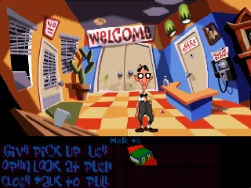 Laverne
is stuck in a tree, 200 years in the future. In the past, George Washington is standing by a window that overlooks this
very same tree, and we are informed that it is a kumquat tree. Now, we know that George is reputedly fond of chopping down
cherry trees, so: Laverne
is stuck in a tree, 200 years in the future. In the past, George Washington is standing by a window that overlooks this
very same tree, and we are informed that it is a kumquat tree. Now, we know that George is reputedly fond of chopping down
cherry trees, so:
| Spoiler: |
| Up in the attic there is a can of red paint. Use it to paint the kumquats red, and we now have something
that looks like a cherry tree. Challenge George to chop it down, and of course he can't resist. 200 years in the future, the
tree disappears and Laverne drops to the ground ;-) |
And here's another little gem of a puzzle:
Nurse Edna is guarding a video recorder that you need access to. You note that she's sitting in a chair with wheels on it,
and you can try pushing her out the door... but then at the last second she grabs onto the arm of a statue near the door,
and this prevents her from flying out into the hallway. So what you need to do to overcome this is:
| Spoiler: |
| Take control of Hoagie, 200 years in the past. Head for the basement lab, and pick up the left-handed hammer
from Red Edison's workbench. Then go up to the third floor, and into the room where sculptor Ned is carving the statue that
you saw in the future. When Ned puts the right-handed hammer down on the barrel, quickly use the left-handed hammer you just
got from the lab with it to make the swap. Now Jed takes over the carving duties, the statue in the future becomes other-handed,
and you can now push Nurse Edna out the door to get rid of her. |
Those are just two examples from a game that has at least a dozen other puzzles as good or even better than that. And it
doesn't commit any of the 9 sins of puzzle design described above.
While not especially brilliant from the puzzle standpoint, the exceptional story line, challenging conversations, and the
fact that this is one of the few games out there with truly different multiple endings combine in a way that makes
The Pandora Directive one of my all time favourite adventure games.
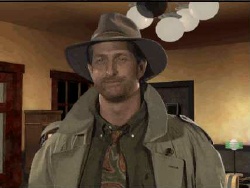 Though
The Pandora Directive has a fair dose of both timed puzzles (in the sense that you get more points the faster you solve
them) and abstract puzzles, it is not without some fairly original puzzles that I had great fun solving. There are several
'puzzle boxes' with intricate locking mechanisms that you need to open in this game, and: Though
The Pandora Directive has a fair dose of both timed puzzles (in the sense that you get more points the faster you solve
them) and abstract puzzles, it is not without some fairly original puzzles that I had great fun solving. There are several
'puzzle boxes' with intricate locking mechanisms that you need to open in this game, and:
| Spoiler: |
| One of them involves a puzzle based on the Mayan calendar. Using such a calendar found in the game, along
with Mayan symbol translations, you have to apply some mathematics to convert 4 Mayan dates to modern dates in order to
align the dials on the puzzle box correctly to open it. Quite a satisfying puzzle once you figure out the required methodology. |
One of my other favourite puzzles in The Pandora Directive involved navigating a maze, but you had to employ a very
novel technique to do it:
| Spoiler: |
| You have to pilot a miniature spaceship toy called an Alien Abductor through a maze of air ducts (that
are too small for Tex to fit into) in order to gather some important objects from sealed rooms in an abandoned military
complex. The remotely controlled Abductor has an arm/gripper that you can use to manipulate and pick up objects. |
One other thing The Pandora Directive had going for it was an expansive 3D environment to explore. Quite advanced for its
time in this respect... OK, and another thing: that wry brand of humour that only a character like Tex Murphy can dish out. What I'm
getting at here is that the whole package is a lot more entertaining than the stuff that passes for adventure games nowadays.
While Day of the Tentacle excelled in the area of inventory-based puzzles, Riven
takes a completly different tack, as do all the Myst games, by employing ingenious
environmental and mechanical puzzles. In fact, though it's not apparent from the outset, the entire world of Riven is
effectively one huge, integrated puzzle!
 In
Riven, you must learn the number system of the local habitants, the D'ni. The system is the key to solving a few of
the puzzles throughout the game, and the Miller brothers added a twist that made this game very difficult for newbies: In
Riven, you must learn the number system of the local habitants, the D'ni. The system is the key to solving a few of
the puzzles throughout the game, and the Miller brothers added a twist that made this game very difficult for newbies:
| Spoiler: |
| Every time you started up a game of Riven, all the puzzles that made use of the D'ni number
system were randomised. This meant that you couldn't just follow a walkthrough if you got stuck, because everyone's game
was different. So you had to master the number system to get through the game. Unlike our own base 10 number system,
the D'ni one was base 25, and involved the superposition of symbols. Lots of fun for grognards like myself, but I did
pity those who didn't have a mathematical background. |
And in the middle part of the game:
| Spoiler: |
| You have to take careful note of the sounds made by certain creatures you come upon through the
course of the game, and associate them with a D'ni number symbol that you found a carving of in that creature's locale. In
order to get to the endgame, you must match a picture of each creature with the associated number. This puzzle was made
even trickier by the fact that there wasn't a number overtly associated with one of the creatures. You had to deduce that
the other numbers were already spoken for. |
The only puzzle sin Riven fell foul of was that, occasionally, pushing a button or throwing a lever in one place
affected another device quite far away (with no ensuing cut scene alerting you to the fact). This could be perceived as a long
dead end of sorts. Because you didn't perform an unobvious action earlier on, you might have to backtrack quite a bit to
rectify the situation. And by that time you probably had no idea what you had neglected to do. Walkthrough time then, and not
really fair.
This game took me quite a while to warm to, not helped by the fact that most of the reviewers who bash adventure games seem
to always mention Grim Fandango in the first paragraph of their review, before launching
into a tirade about how the game being reviewed can't possibly measure up. Don't agree with their premise, but I do agree that
Grim Fandango did set a certain standard regarding both the puzzles and the fun factor.
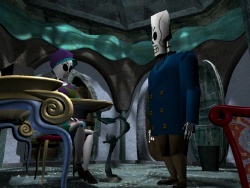 One
puzzle early on in the game is very difficult, but a big part of the above-mentioned fun factor once you twig what to do: One
puzzle early on in the game is very difficult, but a big part of the above-mentioned fun factor once you twig what to do:
| Spoiler: |
| You need to get access to the room where all the assignments are dispatched, so you can intercept
one of your boss' hot tips. So you have to figure out a way to clog the machine that sends the messages through pneumatic
tubes running to every office in your building. The solution involves obtaining two balloons from a street vendor, filling
them with two different kinds of foam that solidify when mixed, and launching them into the system from your office.
Absolutely brilliant. |
But my favourite puzzle in Grim Fandango was:
| Spoiler: |
| You need to obtain a metal detector. There is a large airport-like metal detector in the game, and
an old squeeze of yours, Carla, is manning (womaning?) it. So if you first drink some gold-flake liqueur that you picked up earlier
in the game, and go through the detector, you set it off and Carla takes you into a back room for a more 'thorough' examination with
a portable detector. But because you have no weapons on you, only the gold flakes inside your system, Carla can't find anything. After
repeated attempts to figure out what you have on you, she eventually gives up and throws her portable metal detector out the window,
believing it to be defective ;-) |
Some of the puzzles were a bit far fetched, but don't think they managed to commit any puzzle design sins. Another clean report
card for LucasArts!
Well, it wasn't always all roses in the adventure game heydays either. From Dragon Lore II
(a classic long dead end, artificial obstacles, and pixel hunting), to Atlantis 2 (it's a pity
I don't have my Second Opinion of Atlantis 2 published yet, because that review is way too forgiving of this pile of garbage),
through to Ring: The Legend of the Nibelungen (ditto)... Cryo have repeatedly demonstrated
that they are capable of making games with beautiful graphics, but correspondingly ugly game play.
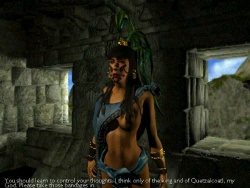 The
following examples of bad puzzle design are taken from my original review of Atlantis 2 for Games Domain, edited slightly
to fit into the context of this article. First up in Atlantis 2 is an artificial obstacle. No need to put this in a spoiler
section because being from a review, the description was vague enough not to give the puzzle away: The
following examples of bad puzzle design are taken from my original review of Atlantis 2 for Games Domain, edited slightly
to fit into the context of this article. First up in Atlantis 2 is an artificial obstacle. No need to put this in a spoiler
section because being from a review, the description was vague enough not to give the puzzle away:
"Then, in China, there's what looks to be a really interesting puzzle that in fact turns out to be a non-puzzle! I spent about
2 hours trying to solve the thing, only to find out that the 'puzzle' was in fact a wild goose chase with multiple solutions. I
had missed the 'solution' because I had read too much into the puzzle set-up. Then every time I tried to work through the puzzle,
I had stopped just short of the 'solution' because I wasn't getting the right cues. I finally twigged what the problem was when
I consulted 2 walkthroughs that had entirely different solutions."
And next we have a timed puzzle that... wasn't supposed to be a timed puzzle:
| Spoiler: |
| You have to get something from the middle of a large spider web. Now, the web has a certain geometry,
and it took me all of 10 minutes to figure out how to traverse the web in order to beat the spiders to the middle... unfortunately,
I had to click on each spot that I wanted to move to next about 5 OR 6 TIMES before the game would register my move (presumably
because my CD drive takes a long time to spin up, it being of the new-fangled 32X variety). In the meantime, the spiders made up
the distance I had gained by using the web geometry to my advantage, and it took me OVER 3 HOURS to finally execute this puzzle
successfully. You couldn't save in the middle of the puzzle, so you had to spend 5 minutes on each attempt just getting back to
the right spot on the web from which to begin the winning manoeuvre. |
Towards the end of the game, there was a another 'puzzle' that almost caused me to give up entirely:
"And then... the Ireland section. This is where it finally dawned on me that Atlantis 2 must have been designed for
adolescent schoolboys, who seemingly have nothing better to do than wander around for weeks through loads of screens looking for
obscure, well hidden objects while attempting to guess what the puzzles actually ARE (you have to say this the way Clive James would
for maximum effect). In this section, you have to find the scattered pieces of a certain broken object. It's a pixel hunt folks. The
worst I've ever seen. I would never have found the last 2 pieces without a walkthrough. Your cursor changes when you finally manage
to place it over one of the pieces, but in these 2 instances the pieces were only a few pixels wide and blended in quite well with
the background."
Enough said about that one. I only finished the game because of a rather firm rule we had at Games Domain: to be allowed to
post a review of an adventure game or RPG, you had to complete it :-
I rate Gabriel Knight 3 as my second favourite adventure of all time, being narrowly
pipped by The Pandora Directive. GK3 doesn't get an Excellent in the puzzle department
either though, because there are one or two of dubious merit in there...
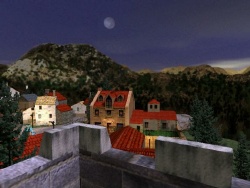 The
following puzzle is the one that seems to always be held up by the mainstream press as the poster child for silly
adventure game puzzle design: The
following puzzle is the one that seems to always be held up by the mainstream press as the poster child for silly
adventure game puzzle design:
| Spoiler: |
| Gabriel needs to disguise himself as his friend Mosely in order to trick the clerk at the bike rental
shop into giving him the motorcycle that Mosely has booked. It involves getting a black cat to squeeze through a hole in a door
where you have placed some sticky tape to obtain a moustache, which you then glue on with maple syrup. You then have to bait a
table with a piece of candy, and nab Mosely's passport from his back pocket when he bends over to pick up the candy. There's more,
but you get the idea... |
Oddly enough, I really enjoyed that puzzle... but that's probably because I had my 'silly adventure gamer beanie cap' on at
the time. On the other hand though, we have one of the longest, toughest, and most rewarding puzzles ever to be found in an
adventure game:
| Spoiler: |
| You discover an epic poem called Le Serpent Rouge. Some of the verses in it contain clues
relating to the geometry of the area surrounding the town where Gabriel and Grace are based, Rennes-le-Chateau. By doing some
research to gather clues, and by solving the likes of anagrams, you are eventually able to pinpoint a very important location by
superimposing a series of lines and shapes on an area map. |
The endgame was also let down by a few timed puzzles, but as with The Pandora Directive, the amazing story line, atmosphere,
and other nice touches serve to make GK3 an enduring classic.
In Part II...
Well, that's probably enough for you to mull over for now. In the concluding part of this article, we'll be having a look at
games from the year 2000 to present, with emphasis on those made in the past three years or so. There will be more space to
discuss individual games in Part II, as this first installment had to, by necessity, include a lot of up-front stuff. See you then.
Copyright © Steve Metzler 2008.
All rights reserved.
|

